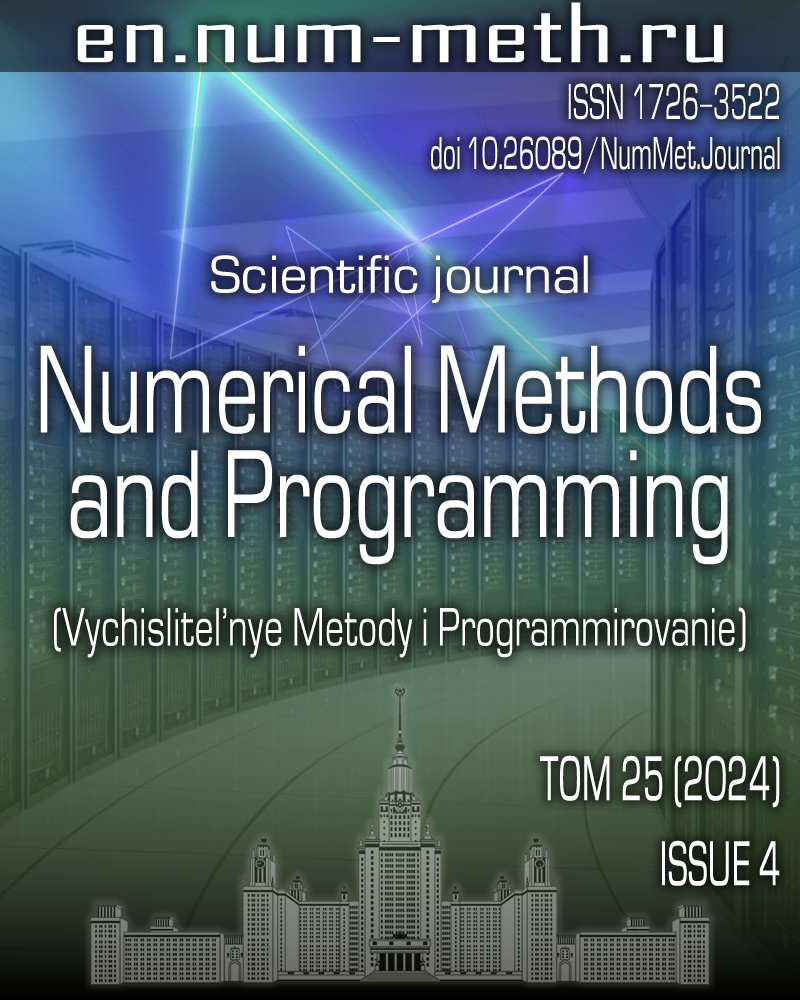DOI: https://doi.org/10.26089/NumMet.v25r431
Averaging of the model of a chemical process in a catalyst layer with a spherical grain
Keywords:
Abstract
The article presents a comparative analysis of models of a non-stationary chemical process using the example of burning coke sedimentation from a catalyst layer with a spherical grain. The first model is obtained by averaging the heat conductivity equation for a spherical catalyst grain. The second is the averaging of the entire grain model, including the diffusion-reaction equations. The comparative analysis showed good consistency of the results under conditions of low concentrations of reagents, small catalyst grains and high process temperatures with a significant reduction in calculation time for the first model. It was found necessary to take into account intradiffusion inhibition at the case of a high reagent concentrations. It causes the occurrence of a concentration gradient along the radius of the catalyst grain at the initial stages of the process.
Published
Issue
Section
References
- G. K. Boreskov and M. G. Slin’ko, “Design of a Contact Apparatus for Sulfurous Gas Oxidation,” J. Chem. Ind. 13 (4), 221-225 (1936).
- A. A. Samarskii, Introduction to the Theory of Difference Schemes (Nauka, Moscow, 1971) [in Russian].
- O. A. Malinovskaya, V. S. Beskov, and M. G. Slin’ko, Modeling of Catalytic Processes on Porous Granules (Nauka, Novosibirsk, 1975) [in Russian].
- M. G. Slin’ko and V. S. Sheplev, “Modeling of Catalytic Processes in a Fluidized Bed,” Kinet. Catal. 11 (2), 531-540 (1970).
- E. A. Lashina, E. E. Peskova, and V. N. Snytnikov, “Mathematical Modeling of the Homogeneous-Heterogeneous Non-Oxidative CH_4 Conversion: The Role of Gas-Phase H or CH_3,” Reac. Kinet. Mech. Catal. 136 (4), 1775-1789 (2023).
doi 10.1007/s11144-023-02442-8. - K. F. Koledina, I. M. Gubaidullin, Sh. G. Zagidullin, et al., “Kinetic Regularities of Hydrogenation of Polycyclic Aromatic Hydrocarbons on Nickel Catalysts,” Russ. J. Phys. Chem. A. 97 (10), 2104-2110 (2023).
doi 10.1134/S003602442309008X. - A. Zagoruiko and P. Mikenin, “Modelling of the Cyclic Chemisorption-Catalytic Process for Production of Elemental Sulfur and Hydrogen from Hydrogen Sulfide,” Chem. Eng. Process.: Process Intensif. 181, Article Number 109169 (2022).
doi 10.1016/j.cep.2022.109169. - R. M. Masagutov, B. F. Morozov, and B. I. Kutepov, Regeneration of Catalysts in Oil Processing and Petrochemistry (Khimiya, Moscow, 1987) [in Russian].
- S. I. Reshetnikov, R. V. Petrov, S. V. Zazhigalov, and A. N. Zagoruiko, “Mathematical Modeling of Regeneration of Coked Cr-Mg Catalyst in Fixed Bed Reactors,” Chem. Eng. J. 380, Article Number 122374 (2020).
doi 10.1016/j.cej.2019.122374. - V. A. Hrisonidi and V. R. Basmanova, “Modern Methods of Regeneration of Catalysts Used in Oil and Gas Synthesis,” The Scientific Heritage. 50 (3), 41-44 (2020).
https://www.elibrary.ru/item.asp?id=43916691 . Cited October 12, 2024. - I. M. Gubaydullin, Mathematical Modelling of Dynamic Modes of Oxidative Regeneration of Catalysts in Motionless Layer (Institute of Petrochemisty and Catalysis, Ufa, 1996) [in Russian].
- Ya. B. Zel’dovich and D. A. Frank-Kamenetsky, “A Theory of Thermal Propagation of Flame,” Phys. Chem. 12 (1), 100-105 (1938).
- O. V. Kiselev and Yu. Sh. Matros, “Propagation of the Combustion Front of a Gas Mixture in a Granular Bed of Catalyst,” Fiz. Goreniya Vzryva 16 (2), 25-30 (1980) [Combust. Explos. Shock Waves. 16 (2), 152-157 (1980)].
doi 10.1007/bf00740193. - A. P. Gerasev, “Non-equilibrium Thermodynamics of Fast Traveling Waves in a Catalytic Fixed Bed. Emergence of Near-equilibrium Spatiotemporal Dissipative Structure,” J. Non-Equilib. Thermodyn. 43 (3), 221-235 (2018).
doi 10.1515/jnet-2018-0005. - A. N. Zagoruiko and A. G. Okunev, “Sorption-Enhanced Steam Reforming of Hydrocarbons with Autothermal Sorbent Regeneration in a Moving Heat Wave of a Catalytic Combustion Reaction,” React. Kinet. Catal. Lett. 91, 315-324 (2007).
doi 10.1007/s11144-007-5168-3. - V. E. Borisov and S. E. Yakush, Numerical Simulation of Methane Flame Propagation in a Gap between Parallel Plates , Preprint No. 4 (Keldysh Institute of Applied Mathematics, Moscow, 2019) [in Russian].
doi 10.20948/prepr-2019-4. - S. Yakush, O. Semenov, and M. Alexeev, “Premixed Propane–Air Flame Propagation in a Narrow Channel with Obstacles,” Energies. 16 (3), 1516-1-1516-19 (2023).
doi 10.3390/en16031516. - I. M. Gubaydullin, E. E. Peskova, O. S. Yazovtseva, and A. N. Zagoruiko, “Numerical Simulation of Oxidative Regeneration of a Spherical Catalyst Grain,” Mat. Model. 34 (11), 48-66 (2022) [Math. Models Comput. Simul. 15 (3), 485-495 (2023)].
doi 10.1134/S2070048223030079. - R. Hughes, Deactivation of Catalysts (Academic Press, New York, 1984).
- V. V. Kafarov, Fundamentals of Mass Transfer (Vysshaya Shkola, Moscow, 1972) [in Russian].
- O. S. Yazovtseva, I. M. Gubaydullin, E. E. Peskova, et al., “Computer Simulation of Coke Sediments Burning from the Whole Cylindrical Catalyst Grain,” Mathematics. 11 (3), 669-1-669-15 (2023).
doi 10.3390/math11030669.
License
Copyright (c) 2024 О. С. Язовцева, И. М. Губайдуллин, И. Г. Лапшин

This work is licensed under a Creative Commons Attribution 4.0 International License.


